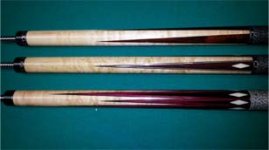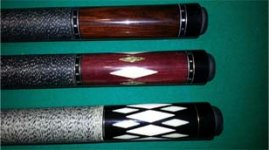WRCues
Registered
Hello everyone, my name is Joel and I'm new here.
I am new to the forum and need help. A little over ten years ago I set down my cue and turned off my lathe. For me pool was a consuming obsession. Like some people who are addicted to cigarettes, I could not "have just one" and be okay. I owned a BBQ restaurant and bar as well as a motorcycle/car repair shop and was neglecting my businesses to spend time in the basement on the pool table or at the lathe. Like any addiction it came to a point where I had to choose and I made the responsible choice and walked away from pool. It was a hard but necessary decision and I made it knowing that some day I would have time to enjoy it again.
Ten years later:
I sold my BBQ joint and closed down my shop, got a part time job, grabbed my cue and ran to the pool hall.
It was like I never left. Except my glasses are a little thicker and the kids I gave lessons to years back now whipped me mercilessly while calling me "Greybush" ( I hope they are just assuming things based on my new hair color.) And everyone is playing with something called an LD shaft, on BLUE cloth, with a clear plastic paper thin rack, breaking softly and alternating breaks regardless of who won the game.
I think all of the changes are for the better. The blue cloth is easier on the eyes, the Magic Racks keep the racks consistent, and the alternate breaks give a guy in a slump a chance to get out of the chair. And as far as the LD shafts..... I am in love. After trying my friends cue with an LD shaft I ran right to a local cue maker (a large cue company) to get a couple made for my cue. $550. I said "no I don't want a cue, just a couple of shafts" Well, that's what 2 LD shafts cost. Nope. can't do it.
But I REALLY like them.
My cue equipment (mostly Hightower machines) is long gone. Some was sold off, some was gifted to a young aspiring cuemaker years ago. I do have an old Atlas 10" lathe that I used in my repair shop for making parts for old Harleys. I got that out, cleaned it up, and made a list of items and parts I need to outfit it for cue making. ( I am going to contact Chris Hightower to see if he has parts to convert this lathe. Chris if you are reading this please post a reply.) I have a pile of Hard Maple boards that something told me to hang on to, a planer, a router table, a band saw, and a drill press.
Through research and investigation I have found out basic construction principles, but could really use some advice on how to build these shafts as well as the theories that cuemakers have about which designs work the best.
Any help would be appreciated. Thanks to all who lend a hand! - Joel
I am new to the forum and need help. A little over ten years ago I set down my cue and turned off my lathe. For me pool was a consuming obsession. Like some people who are addicted to cigarettes, I could not "have just one" and be okay. I owned a BBQ restaurant and bar as well as a motorcycle/car repair shop and was neglecting my businesses to spend time in the basement on the pool table or at the lathe. Like any addiction it came to a point where I had to choose and I made the responsible choice and walked away from pool. It was a hard but necessary decision and I made it knowing that some day I would have time to enjoy it again.
Ten years later:
I sold my BBQ joint and closed down my shop, got a part time job, grabbed my cue and ran to the pool hall.
It was like I never left. Except my glasses are a little thicker and the kids I gave lessons to years back now whipped me mercilessly while calling me "Greybush" ( I hope they are just assuming things based on my new hair color.) And everyone is playing with something called an LD shaft, on BLUE cloth, with a clear plastic paper thin rack, breaking softly and alternating breaks regardless of who won the game.
I think all of the changes are for the better. The blue cloth is easier on the eyes, the Magic Racks keep the racks consistent, and the alternate breaks give a guy in a slump a chance to get out of the chair. And as far as the LD shafts..... I am in love. After trying my friends cue with an LD shaft I ran right to a local cue maker (a large cue company) to get a couple made for my cue. $550. I said "no I don't want a cue, just a couple of shafts" Well, that's what 2 LD shafts cost. Nope. can't do it.
But I REALLY like them.
My cue equipment (mostly Hightower machines) is long gone. Some was sold off, some was gifted to a young aspiring cuemaker years ago. I do have an old Atlas 10" lathe that I used in my repair shop for making parts for old Harleys. I got that out, cleaned it up, and made a list of items and parts I need to outfit it for cue making. ( I am going to contact Chris Hightower to see if he has parts to convert this lathe. Chris if you are reading this please post a reply.) I have a pile of Hard Maple boards that something told me to hang on to, a planer, a router table, a band saw, and a drill press.
Through research and investigation I have found out basic construction principles, but could really use some advice on how to build these shafts as well as the theories that cuemakers have about which designs work the best.
Any help would be appreciated. Thanks to all who lend a hand! - Joel


